How one weird fish's incredible ability to suspend aging could help humans
The African killifish may be the best hope we have for reversing — or even halting — the aging process.

In the quest for eternal life, humans have come up with all kinds of schemes to halt the aging process. From hacking our DNA to blood transfusions, to supplements, and even intermittent fasting, scientists and lay people alike want to know: How can we reverse — or better yet, stop — the aging process?
It would be convenient if we could just hit the pause button whenever we wanted, right? But for one weird tropical fish, doing just that is no pipe dream. In fact, taking a break from aging is key to the development of these strange aquatic creatures, a new study suggests. Humans, take notes.
This new hope for a Fountain of Youth comes from the African turquoise killifish, Nothobranchius furzeri. When the going gets tough — like during dry seasons, when conditions are unfavorable for its growth — the fish enters a special state called diapause — literally suspending its aging process.
Diapause is similar to hibernation: animals in diapause are in a dormant state where their bodies are less active than usual. But while hibernation involves a seasonal rest period when temperatures are too cold for animals to thrive, in diapause, animals press the snooze button on their very development. Once conditions are more favorable, development starts right back up as if no time had passed.
Of course, time itself does not stop. But what is really wild about diapause is that the time that passes while an organism is dormant does not count against its overall life span.
Diapause completely upends the very idea of aging as a time-based process that marches inexorably toward an individual’s inevitable demise.
This video explains the incredible science behind the killifish's weird abilities — and why humans should take note.
In the new study, researchers show, for the first time, how this process works in embryos of the African turquoise killifish — and which specific gene groups are responsible for it. The genes involved in the fish’s muscle development and function, it turns out, play a particularly crucial role in diapause.
The findings were published Thursday in the journal Science.
Curious killifish
Killifish lives in ponds that vary greatly with weather — during drought, they fully dry up, making it difficult for the fish to survive as usual. That is where diapause comes in, giving them a waiting period before things get better and they can continue to grow.
Some insects, other fish, crustaceans, and nematodes also go through diapause, studies suggest. But discovering how diapause actually works opens up new research doors for better understanding those animals — and even the human aging process.
“These findings might provide insight into the mysteries of aging and longevity,” University of Washington researcher Marc Van Gilst writes in a commentary on the research, also published Thursday in Science.
“African turquoise killifish embryos are protected from the wear and tear of time, meaning that the killifish diapause possesses vertebrate anti-aging mechanisms potentially of considerable relevance to human aging.”
The African killifish embryo suspended in a state of diapause.
Since the African turquoise killifish has complex immune, nervous, and cardiovascular systems, studying them helps shed light on other complex vertebrate species to see how those organ systems are affected by diapause.
The fish also can fall victim to the same aging-related diseases that affect humans and other vertebrates. And since killifish live only four to six months, they are particularly helpful study subjects in looking at an entire lifespan, Van Gilst says.
While researchers still don’t understand precisely what protects the killifish, or other vertebrates, from aging during diapause, the study is a step forward.
It “provides some of the first insight into the anti-aging mechanisms of vertebrate diapause,” Van Gilst says.
Abstract: Diapause is a state of suspended development that helps organisms survive extreme environments. How diapause protects living organisms is largely unknown. Using the African turquoise killifish (Nothobranchius furzeri), we show that diapause preserves complex organisms for extremely long periods of time without trade-offs for subsequent adult growth, fertility, and life span. Transcriptome analyses indicate that diapause is an active state, with dynamic regulation of metabolism and organ development genes. The most up-regulated genes in diapause include Polycomb complex members. The chromatin mark regulated by Polycomb, H3K27me3, is maintained at key developmental genes in diapause, and the Polycomb member CBX7 mediates repression of metabolism and muscle genes in diapause. CBX7 is functionally required for muscle preservation and diapause maintenance. Thus, vertebrate diapause is a state of suspended life that is actively maintained by specific chromatin regulators, and this has implications for long-term organism preservation.